ICSE Biology Previous Year Question Paper 2015 Solved for Class 10
ICSE Paper 2015 BIOLOGY
SECTION-I (40 Marks)
(Attempt all questions from this Section )
Question 1:
(a) Name the following :
(i) The process of uptake of mineral ions against the concentration gradient using energy from cell.
(ii) The form in which glucose is stored in liver.
(iii) The vein that carries oxygenated blood.
(iv) The cross between two parents having one pair of contrasting characters.
(v) The structure formed by the villi of the ernbtyu and the uterus of the mother. [5]
(b) The statement given below are False. Rewirte the correct form of the statement by changing the word which is underlined:
(i) Alpha cells of pancreas secrete Insulin.
(ii) Formalin is an example of an Antiseptic.
(in) CNG is mainly responsible for the formation of acid rain
(iv) Sulphadiaztne is an example of an Antiseptic.
(v) Cretinism is caused due to deficiency of Adrenaline. [5]
(c) Choose the correct answer from the four options given below:
(i) A single highly coiled tube where sperms are stored, gets concentrated and mature is known as
(A) Epididymis (B) Vas efferentia (C) Vas deferens (D) Seminiferous tubule
(ii) Chromosomes get aligned at the center of the cell during
(A) Metaphase (B) Anaphase (C) Prophase (D) Telophase
(iii) BCG vaccine is effective against:
(A) Cholera (B) Mumps (C) Tuberculosis (D) Measles
(iv) Which one of the following is mainly associated with the maintenance of the posture ?
(A) Cerebrum (B) Cerebellum (C) Thalamus (D) Pons
(v) An example of non-biodegradable waste is
(A) Vegetable peels (B) Sewage (C) Livestock waste (D) DDT [5]
(d) Mention the exact location of the following structures :
(i) Thylakoids (ii) Organ of Corti (iii) Lenticels (iv) Bicuspid Value (v) Loop of Henle [5]
(e) The diagram given below represents a certain stage of mitosis :
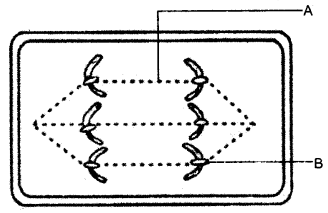 (i) Identify the stage of cell division.
(i) Identify the stage of cell division.
(ii) Name the parts labelled A and B.
(iii) What is the unique feature observed in this stage ?
(iv) How many daughter cells formed from this type of cell division ? [5]
(f) Given below is an example of a certain structure and its special functional activity. On a similar pattern fill in the blanks with suitable functions :
Example : Chloroplast and Photosynthesis
(i) Xylem and ……… .
(ii) Ciliary Body and ……… .
(iii) Seminiferous Tubule and ……… .
(iv) Thyroid gland and ……… .
(iv) Eustachian Tube and ……… . [5]
(g) Rewrite and complete the following sentences by inserting the correct word in the space indicated :
(i) The phenomenon of loss of water through a cut stem or injured part of plant
is called ………
(ii) ……… is the scientific, name of garden pea, which Mendel used for his experiments.
(iii) A fluid that occupies the larger cavity of the eye ball behind the lens is ………
(iv) Oxygen combines with haemoglobin present in RBC and forms ………
(v) ……… causes corrosion of the marble or brick surface. [5]
(h) Match the items in Column A with the most appropriate ones in Column B. Rewrite the matching pairs as shown in the example :
Example : Fibrinogen – Clotting of blood. [5]
| Column A | Column B |
| (1) Allele | (a) Control of automobile exhaust |
| (2) Leydig cells | (b) Tourniquet |
| (3) Utriculus | (c) Alternate forms of genes |
| (4) Snake bite | (d) Dynamic equilibrium |
| (5) Euro IV norms | (e) Testosterone |
| (f) Sudden change in genes | |
| (g) Static equilibrium |
Answers:
(a) (i) Active Absorption
(ii) Glycogen
(iii) Pulmonary vein
(iv) Monohybrid cross
(v) Placenta.
(b) (i) Alpha cells of pancreas Secrete glucagon.
(ii) Formalin is an example of Disinfectant.
(iii) Fossil fuel is mainly responsible for acid rain.
(iv) Sulphadiazine’is an example of Sulphonamide.
(v) Cretinism is caused by deficiency of Thyroxine.
(c) (i) (A) Epididymis
(ii) (A) Metaphase
(iii) (C) Tuberculosis
(iv) (B) Cerebellum
(v) (D) DDT
(d) (i) Thylakoids: In the grana of the chloroplast in plant cells.
(ii) Organ of Corti: In the endolymph present in the middle concentric layer of cochlea in the internal ear.
(iii) Lenticels: On the older stem of plants.
(iv) Bicuspid value: Between the left auricle and left ventricle.
(v) Loop of Henle: In the medulla part of kidney.
(e) (i) Anaphase.
(ii) A – Spindle fibre. B-Centromere
(iii) The sister chromatids of each chromosome have split apart and moved away from each other.
(iv) Two.
(f) (i) Xylem and upward transport of water and minerals.
(ii) Ciliary body and alter the shape of the lens of eye.
(iii) Seminiferous tubule and production of sperms in testes.
(iv) Thyroid gland and regulate basal metabolism.
(v) Eustachean tube and equalize air pressure on either side of the ear drum.
(g) (i) The phenomenon of loss of water through a cut stem or injured part of plant is called bleeding.
(ii) Pisum sativum is the scientific name of garden pea, which Mendel used for his experiments.
(iii) A fluid that occupies the larger cavity of the eye ball behind the lens is vitreous humour.
(iv) Oxygen combines with- haemoglobin present in RBC and forms, Oxyhaemoglobin.
(v) Acid rain causes corrosion of the marble or brick surface.
(h)
| Column A | Column B |
| (1) Allele | (c) Alternate forms of genes |
| (2) Leydig cells | (e) Testosterone |
| (3) Utriculus | (g) Static equilibrium |
| (4) Snake bite | (b) Tourniquet |
| (5) Euro IV norms | (a) Control of automobile exhaust |
SECTION-II (40 Marks)
(Attempt any Four questions from this Section.)
Question 2:
(a) The diagram alongside shows two test-tubes A and B. Test-tube A contains a green water plant. Test-tube B contains both a green water plant and a snail. Both Test-tubes are kept in sunlight. Answer the questions that follow :
 (i) Name the physiological process that releases the bubbles of oxygen.
(i) Name the physiological process that releases the bubbles of oxygen.
(ii) Explain the physiological process as mentioned above in Q. 2. (a) (i).
(iii) What is the purpose of keeping a snail in test-tube ‘B’ ?
(iv) Why does test-tube ‘B’ have more bubbles of oxygen ?
(v) Give an example of a water plant that can be used in the above experiment.
(vi) Write the overall chemical equation for the above process. [5]
(b) Given the biological / technical terms for the following :
(i) A mixture of smoke and fog.
(ii) Capacity of our body to resist diseases.
(iii) Fixing of developing zygote on the uterine wall.
(iv) The permanent stoppage of menstruation at about the age of 45 years in a female.
(v) The hormone increasing reabsorption of water by kidney tubules.
(vi) A thin membrane covering the entire front part of the eye.
(vii) The lens of eye losing flexibility resulting in a kind of long-sightedness in middle aged people.
(viii) The number of persons living per square kilometre at any given time.
(ix) The sound produced when the atrio-ventricular valves close in the heart.
(x) The process by which blood cells engulf bacteria. [5]
Answer:
(a) (i) Photosynthesis.
(ii) It is a process in which green plants (plant cells having chlorophyll) take in carbon-di-oxide and water in presence of light to produce glucose and release oxygen gas.
(iii) So that snail can release carbon di oxide into the water for plant.
(iv) Rate of photosynthesis is more in test tube B because the plant in B gets more C02 from the snail.
(v) Hydrilla.
(vi)

(b) (i) Smog
(ii) Immunity
(iii) Implantation
(iv) Menopause
(v) Antidiuretic hormone/vasopressin.
(vi) Conjuctiva.
(vii) Presbyopia
(viii) Population density
(ix) LUBB
(x) Phagocytosis
Question 3:
(a) An apparatus as shown alongside was set up to investigate a physiolo¬gical process in plants. The setup was w kept in sunlight for two hours. Droplets of water were then seen inside the bell jar. Answer the questions that follow :
 (i) Name the process being studied.
(i) Name the process being studied.
(ii) Explain the process named above m Q. 3. (a) (i).
(iii) Why was the pot covered with a plastic sheet ?
(iv) Suggest a suitable control for this experiment.
(v) Mention two ways ip, which this process is beneficial to plants.
(vi) List three adaptations in plants to reduce the above mentioned process. [5]
(b) Briefly answer the following questions.
(i) State two reasons for the increase of population in India.
(ii) What is the significance ofamniotic fluid ?
(iii) What is the function of ear ossicles ?
(iv) Mention any two activities of the WHO.
(v) State Mendel’s Law of Dominance. [5]
Answer:
(a) (i) Transpiration.
(ii) The process in which plants lose water in the form of vapour from its aerial parts.
(iii) To prevent escape of the soil water as vapour.
(iv) A similar set up without a living plant.
(v) 1. Due to transpiration there is an upward movement of water so roots can absorb more water and thus minerals from soil.
2. The transpired water forms a cool blanket around the plant thus protecting it from the heat of sun.
(vi) 1. The stomata are sunken into pits.
2. The stomata are covered by hair.
3. The leaf is narrow to reduce the number of stomata.
(b) (i) 1. Desire for a male child due to which parents continue to have children till they get a son.
2. Children are considered as earning hand in the economically weaker section.
(ii) It is a shock absorber for the growing foetus. It prevents the sticking of the foetus to the amnion.
(iii) They magnify/amplify sound vibrations and transmit it to the inner ear.
(iv) 1. Set pharmaceutical standards.
2. Suggest quarantine measures for various contagious diseases.
(v) When one pair of contrasting characters are crossed with each other, the F1 generation in its phenotype shows only one character. The character that is visible is called dominant whereas the suppressed character is called recessive.
Question 4:
(a) The diagrams given below are cross sections of blood vessels :
 (i) Identify the blood vessels A, B and C.
(i) Identify the blood vessels A, B and C.
(ii) Name the parts labelled 1 to 3.
(iii) Name the type of blood that flows through A.
(iv) Mention one structural difference between A and B.
(v) In which of the above vessels does exchange of gases actually take place ? [5]
(b) Differentiate between the following pairs on the basis of what is mentioned within brackets:
(i) Diffusion and Osmosis (Definition)
(ii) RBC and WBC (Shape)
(iii) Tubectomy and Vasectomy (Part cut and tied)
(iv) Vasopressin and Insulin (Deficiency disorder)
(v) Rods and Cones of Retina (Type of pigment). [5]
Answer:
(a) (i) 1. Connective tissue layer 2. Lumen 3. Muscular layer
(ii) Oxygenated blood.
(iii) A = Artery, B = Vein, C = Capillary.
(iv)
| A | B |
| 1. Thick muscular and elastic layer as wall. | 1. Thin muscular and less elastic wall. |
| 2. Narrow lumen | 2. Wide lumen. |
(v) In C/Capillary.
(b) (i) Diffusion: Process of flow of solvent, solute or gaseous molecules from high concentration to low concentration. When the two are in direct contact.
Osmosis: Process of flow of solvent molecules from low concentration to high concentration through a semi permeable membrane.
(ii) RBC: Biconcave, spherical, disclike, non-nucleated.
WBC: Amoeboid, nucleated.
(iii) Tubectomy: Oviduct/Fallopian tube.
Vasectomy: Spermduct/Vas deferens.
(iv) Vasopressin: Diabetes insipidus.
Insulin: Diabetes mellitus
(v) Rods: Rhodospin.
Cones: Iodopsin.
Question 5:
(a) The diagram given below shows a section of a human kidney. Study the diagram carefully and answer the questions that follow :
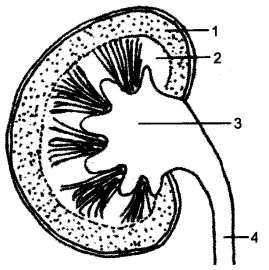 (i) Label the parts numbered 1 to 4.
(i) Label the parts numbered 1 to 4.
(ii) Why does part ‘2’ have a striped appearance ?
(iii) What is the fluid that passes down part ‘4’ ? Name the main nitrogenous waste present in it.
(iv) Mention the structural and functional units of kidneys.
(v) Name the two major steps in the formation of the fluid mentioned in Q. 5. (a) (iii). [5]
(b) Draw neat and labelled diagrams of the following :
(i) Malpighian Capsule. (ii) A Myelinated Neuron. [5]
Answer:
(a) (i) 1. Cortex 2. Medulla 3. Pelvis 4. Ureter.
(ii) Part 2 (Medulla) has the loop of Henle of all the nephrons. So they have appearance like stripes.
(iii) Urine, Urea.
(iv) Nephron/Kidney tubule/Renal tubule.
(v) 1. Ultrafiltration and 2. Selective Readsorption.
(b) (i) Malpighian Capsule.
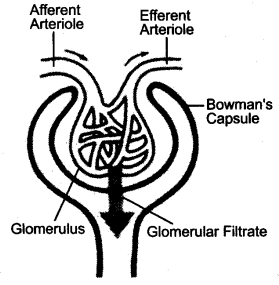
(ii) Myelinated Neuron.
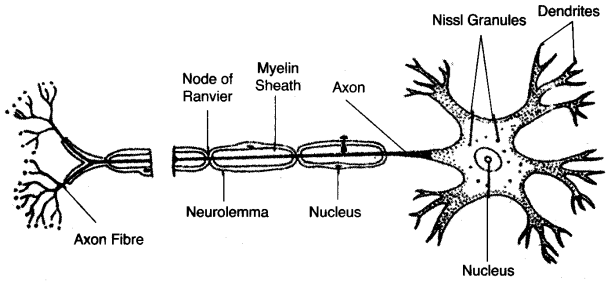
Question 6:
(a) The diagram given below shows the male urinogenital system of a human being. Study the diagram and answer the questions that follow :
 (i) Label the parts numbered 1 to 8.
(i) Label the parts numbered 1 to 8.
(ii) Name the corresponding structure of part (4) in female reproductive system.
(iii) What is the role of part 7 ? [5]
(b) In a homozygous plant round seeds (R) are dominant over wrinkled seeds (r) :
(i) Draw a Punnett square to show the gametes and offspring when both the plants have heterozygous round seeds (Rr).
(ii) Mention the Phenotype and Genotype ratios of the offsprings in F2 generation.
(iii) Name the sex chromosomes in human males and females.
(iv) Briefly explain the term ‘Mutation’.
(v) What is the number of chromosomes in the gametes of human beings ? [5]
Answer:
(a) (i) 1. Urinary bladder
2. Ureter (left)
3. Prostate gland
4. Vas deferens/Sperm duct
5. Urethra
6. Testes
7. Scrotum
8. Epididymis
(ii) Fallopian tube/Oviduct.
(iii) It protects testis and regulate temperature of testes for sperm production.
(b) (i)
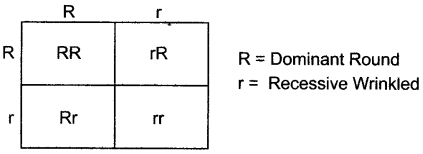
(ii) Genotypic ratio – 1:2:1
1. Homozygous round
2. Heterozygous round
3. Homozygous wrinkled Phenotypic ratio = 3:1
(iii) Human male sex hormone = Testosterone
Human female sex hormone = Oesterogen Progesterone.
(iv) Mutation : The sudden change in one or more genes which changes the hereditary materials of a cell which in turn changes the character of an organism.
(v) 23.
Question 7:
(a) The diagram given alongside represents the human heart in one phase of its functions. Study the diagram carefully and answer the questions that follow :
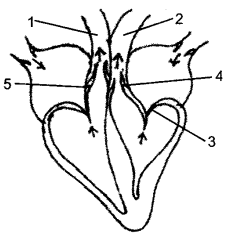 (i) Name the phase.
(i) Name the phase.
(ii) Which part of the heart is contracting in this phase ? Give a reason to support your answer.
(iii) Name the parts labelled 1 to 4.
(iv) What type of blood flows through ‘2’ ?
(v) State the function of the part numbered ‘5’ ?
(vi) Name the membrane that covers the heart. [5]
(b) Explain the following terms :
(i) Greenhouse effect.
(ii) Turgor pressure.
(iii) Selective reabsorption.
(iv) Natality.
(v) Pulse. [5]
Answer:
(a) (i) Ventricular Systole.
(ii) Ventricle is contracting because both tricuspid and bicuspid valves are closed whereas both pulmonary semi-lunar and Aortic semilunar valves are open to pump the blood out of the two ventricles.
(iii) 1. Pulmonary artery
2. Aorta
3. Bicuspid/Mitral valve.
4. Aortic semi-lunar valve
5. Tricuspid values.
(iv) Oxygenated blood flows through part 2.
(v) Allow deoxygenated blood to flow from right ventricle to lungs and prevents its back flow.
(vi) Pericardium.
(b) (i) Green house effect: Due to increasing concentration of carbondioxide in the atmosphere the heat of the sun remains trapped in the atmosphere and does not radiate back. This effect is called Green house effect.
(ii) Turgor Pressure: The pressure exerted by the cell contents of a turgid cell onto the wall of cell.
(iii) Selective Absorption: The process of reabsorbing selected useful substances like water, glucose, mineral ions etc. from the glomerular filtrate by the blood capillaries as they are flowing through the proximal convoluted tubule, loop of Henle and distal convoluted tubule.
(iv) Natality: The number of live birth per thousand per year.
(v) Pulse: It is the rhythmic coiling of arteries as the blood flows through it with every pumping of heart.